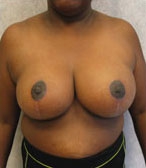Breast Reduction
Full breasts are often associated with femininity and beauty. However, when breasts become disproportionately large, they can bring with them not only cosmetic concerns but also significant physical challenges. Heavy breast tissue can strain the back, shoulders, and neck, create skin irritation, and limit the ability to enjoy certain physical activities. Many women also feel self-conscious about their appearance, finding that their breast size makes it difficult to achieve balance in their figure.
If the description of these struggles is all too familiar to you, you may benefit from breast reduction surgery. Our Bethesda plastic surgeon has performed countless breast reduction procedures, and is well-versed in recent techniques for this sought-after option. He understands that the term “breast enhancement,” both for health and for beauty, can describe both augmentation and reduction.
*Individual Results May Vary
- What Is Breast Reduction Surgery?
- Breast Reduction Candidates
- Breast Reduction vs. Breast Lift Surgery
- Breast Reduction Procedure
- Breast Reduction Recovery
- Breast Reduction Cost
Breast Reduction Surgery at a Glance
- Sedation: General anesthesia
- Potential Benefits: A smaller, more proportionate, and more symmetrical bustline; reduction of unwanted physical and mental concerns related to overly large breasts
- Potential Risks: Bruising, swelling, tenderness; (less commonly) infection, blood clots, adverse reactions to anesthesia
- Procedure Length: Approximately two to five hours*
- Recovery Time: Patients can usually resume work after a week; strenuous exercise should be avoided for about a month
- Cost: Variable
What Is Breast Reduction Surgery?
Breast reduction surgery can do far more than simply decrease breast size. In addition to removing excess tissue, the surgery can reshape the breasts, enhance symmetry, and refine the size, shape, and position of the areola. The result is often a lighter, more proportionate, and more aesthetically pleasing bustline.
To perform the procedure, Dr. Richards removes excess fat and glandular tissue through carefully placed incisions. He then reshapes the breast mound into a natural, conical form and secures it to the underlying muscle fascia for long-lasting support. Finally, he removes excess skin and redrapes the breast to achieve a firmer, more youthful contour.
If patients desire, breast reduction surgery may be complemented by tummy tuck surgery, a Brazilian butt lift, facial enhancement procedures, or other options for a more comprehensive rejuvenation. Dr. Richards will be glad to discuss your aesthetic goals during a first-time consultation.
Who Is a Candidate for Breast Reduction?
Candidates for breast reduction surgery often wish to address:
- Chronic physical discomfort such as back, neck, or shoulder pain related to the weight of their breasts
- Postural problems or stooping caused by the strain of heavy breast tissue
- Skin concerns like rashes, irritation, or chafing beneath the breasts
- Shoulder indentations from bra straps digging into the skin
- Difficulty with exercise or daily activities due to breast size interfering with movement
- Clothing challenges, such as limited wardrobe options or difficulty finding supportive bras
- Emotional or self-image concerns stemming from feeling self-conscious or disproportionate because of breast size
Ideal candidates should also be in good general health, non-smokers (or willing to quit in advance of surgery), and have realistic expectations about the procedure and its results.
By addressing both physical symptoms and aesthetic balance, breast reduction surgery can provide long-lasting relief and help women feel more confident, comfortable, and in control of their daily lives.
Breast Reduction vs. Breast Lift Surgery
While a breast reduction and a breast lift are often discussed together, they are performed for different reasons. A breast lift focuses primarily on repositioning the breasts to a higher, more youthful location by removing excess skin and reshaping the existing tissue. Although this procedure can enhance firmness and contour, it cannot significantly alter breast size.
A breast reduction, on the other hand, is intended to decrease the overall weight and volume of the breasts while also creating a lifted, more proportional shape. In many cases, the nipple and areola are elevated and refined for a natural-looking outcome.
For women struggling with discomfort, posture problems, or activity limitations due to overly large breasts, a reduction can offer both physical relief and cosmetic improvement. For those who simply want a more youthful and supported appearance without changing size, a lift may be the more appropriate option. Dr. Richards works closely with each patient to determine which procedure (or a combination of the two) may best align with their needs and goals.
What Does the Breast Reduction Procedure Involve?
When you meet with Dr. Richards for your consultation, he will take time to carefully review your medical history, examine your anatomy, and discuss your personal goals. From there, he will design a surgical plan that reflects both your cosmetic wishes and your physical needs. Because no two patients are exactly alike, the approach used for breast reduction varies depending on breast size, tissue composition, and the amount of lifting required.
Several incision techniques can be utilized for breast reduction surgery:
- Benelli (Donut) incision – a circular incision placed around the areola
- Vertical (Lollipop) incision – an incision around the areola with a vertical line extending downward
- Anchor incision – an incision around the areola, vertically down the breast, and along the inframammary fold
In some instances, liposuction may be considered to address fatty tissue (but cannot reduce glandular breast tissue and may leave excess skin behind). VASER® LipoSelection® can sometimes be used in combination with traditional breast reduction to contour the sides of excessively wide breasts while preserving nerves and blood supply.
Because natural breast asymmetry is very common, Dr. Richards may remove more tissue from one breast than the other to achieve a balanced, harmonious result. Throughout the procedure, his goal is to reshape the breast mound into a lighter, more proportional contour while repositioning the nipple-areola complex for a natural appearance.
During your consultation, Dr. Richards will walk you through every step of the operation, explain the incision options most appropriate for your case, and outline the recovery process.
What Does Breast Reduction Recovery Involve?
Breast reduction surgery is usually performed on an outpatient basis, meaning most patients return home the same day, though an overnight hospital stay may sometimes be recommended. Drains may be placed, and Dr. Richards will provide detailed instructions on how to care for your bandages both before and after surgery. It is normal to experience swelling, tenderness, and bruising, which can be managed with prescribed medication.
Patients are generally advised to rest and take about a week off from work and regular duties, though recovery varies; some women feel comfortable resuming light, non-strenuous activity after only a few days. Strenuous and high-impact exercises should be avoided for about one month, or until Dr. Richards advises otherwise.
Incisions will take time to mature, but most patients find that scars fade, soften, and blend into the surrounding skin over time. Although scarless surgery is not possible, Dr. Richards employs advanced techniques to minimize their visibility, and many women feel the improvement in comfort and confidence far outweighs the presence of incision lines. Moreover, scar healing can be optimized with in-office pulse-dye laser treatments and the use of topical silicone gel products, which Dr. Richards may recommend during follow-up visits.
While changes in breast size are usually noticeable right away, it may take several months or longer for swelling to fully resolve. Many women report immediate relief from discomfort, though final results continue to refine as healing progresses. To maintain your results, a healthy diet and active lifestyle are encouraged. While small weight fluctuations should not dramatically affect breast size, significant weight gain could cause regrowth of tissue and the return of previous symptoms. Fortunately, many patients find that once their breasts are more comfortable, they enjoy exercise more and often lose weight rather than gain it.
Listening to your body and avoiding overexertion is key during the early healing period. Throughout this time, Dr. Richards and our team remain available to guide your recovery and answer questions.
How Much Does a Breast Reduction Cost?
The cost of breast reduction surgery can vary widely, depending on factors such as surgeon’s fees, facility and hospital expenses, anesthesia, and pre- and post-operative care.
At your initial consultation, Dr. Richards and our team will review your goals, evaluate your unique needs, and present a detailed breakdown of anticipated costs for your breast reduction surgery. Our goal is to give you clear, transparent information so you feel confident moving forward with the treatment plan that best fits your expectations and lifestyle.
Will insurance cover the procedure?
Many types of medical insurance plans offer at least partial coverage for a breast reduction, although you should speak with your insurance company representative to determine what costs, if any, may be covered. Most insurance plans require patients to demonstrate a need for the procedure, citing documented examples of physical pain or non-surgical attempts to address the problem. They may also instruct the policyholder to try and lose weight prior to approving the surgery. We can help you navigate this process and submit a claim for you.
For more information about breast reduction, or to schedule a consultation, please contact us today. We are happy to answer your questions and help you in any way we can.

